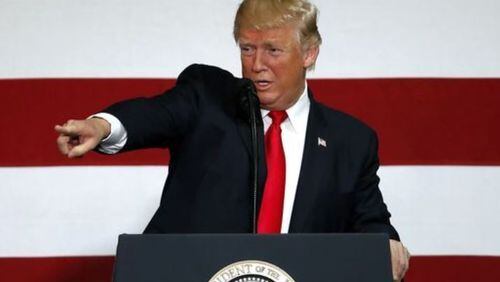President Donald Trump invoked a Republican famous for tax cutting in an opinion article for the Milwaukee Journal Sentinel that called on Congress to pass his tax reform bill.
Some economists say Reagan’s reduction in the corporate tax rate helped boost the economy. But seven experts we spoke to were unanimous in saying a single tax cut can’t be credited for dramatic gains in an economy that is affected by a host of taxes, as well as many factors not related to taxes, such as demographics and trade policies.
“Mathematically, he’s on firm ground” in economic growth and increases in median income in the years after the corporate rate cut, Manhattan Institute senior fellow Brian Riedl said of Trump’s claim.
But, “It’s always very hard to specify which policies led the economy to perform the way it did,” Riedl said.
University of Wisconsin-Madison professor emeritus of applied economics Andrew Reschovsky, who worked in the Office of Tax Analysis at the U.S. Treasury said, "The problem is, economies are complex things. It is really impossible to attribute any change" to a single tax cut.
To back Trump’s claim about the effects of the 1986 corporate tax rate cut, the White House cited several statistics indicating the economy improved during the next several years.
Among them: A 4.2 percent increase in gross domestic product in 1988, according to the World Bank; and an increase of nearly $2,000 — from $51,388 to $53,367 — in the real median household income, from 1986 to 1989.
But there are two important points to consider here, the economists told us.
1. The corporate tax rate cut — from 46 percent to 34 percent — was only one of a host of cuts in the Tax Reform Act of 1986.
The legislation also reduced the top marginal individual income tax rate from 50 percent to 28 percent and cut the number of income brackets from 14 to two, among many other tax changes. As the Washington Post reported, “tax shelters for the wealthy, which proliferated before the bill became law, were struck a mortal blow,” the “once-all-powerful oil-and-gas lobby also had a few of its tax benefits clipped” and “millions of low-income Americans were taken off the income tax rolls entirely.”
Bruce Bartlett, a domestic policy adviser in the Reagan White House, said, “The economy did not boom. It grew at about the same rate as before the tax reform and by 1990 was tanking.”
University of California, Berkeley economist Alan Auerbach, the author of an American Economic Association journal article on the economic effects of the 1986 tax reform law, gave a more positive view:
“The economy did OK after 1986 until the 1990-91 recession, but there was no significant change in the economy’s overall trajectory immediately after the 1986 act,” he said. “The economy did boom in the mid- to late-1990s, and the middle class did relatively well during that period, but it’s hard to attribute that to the 1986 act.”
2. Many factors aside from taxes help determine the performance of the economy.
While the economy improved after the various 1986 Reagan tax changes, "you had a lot of winds behind the sails," said Tax Policy Center former co-director Eugene Steuerle, who was deputy assistant secretary of the U.S. Department of the Treasury for Tax Analysis under Reagan. He cited baby boomers reaching their peak earning years and more women entering the workforce.
Our rating
Some economists say the corporate rate reduction did help lead to economic growth and higher income. But it wasn’t necessarily more important than a cut from 50 percent to 28 percent in the top individual income tax rate that was part of the same 1986 package that included other tax changes, as well.
Many other factors beyond tax cuts — demographics, immigration, trade policy and more — bear on the economy.
Trump's statement contains only an element of truth — our definition of Mostly False.
“In 1986, President Ronald Reagan” cut the business tax rate to 34 percent and “it worked — our economy boomed, the middle class thrived and median family income increased.”
— President Donald Trump on Sunday, Sept. 3, 2017 in an op-ed in the Milwaukee Journal Sentinel






